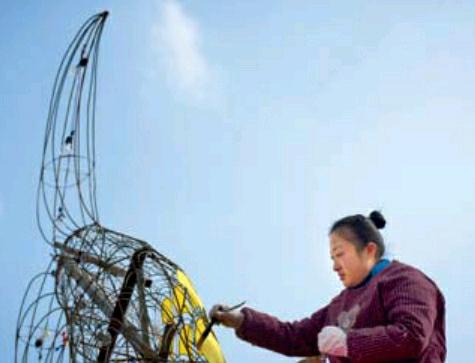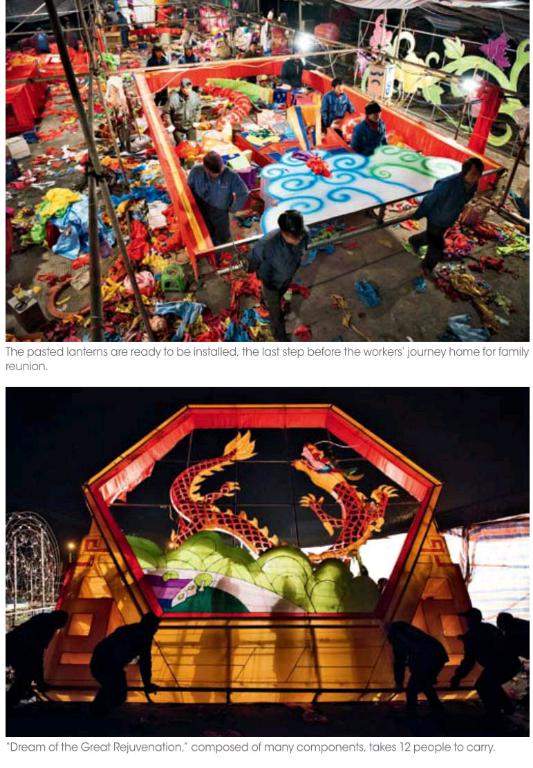Night Lights
2016-03-17byTaoTiandong
by+Tao+Tiandong
A highlight of Chinas biggest holi- day, Spring Festival, is the lights, which inject special flavor into the occasion. Every year, for example, the river region of Qianjiang in Chongqing, one of the four municipalities under the direct jurisdiction of the Central Government, embraces the Chinese New Year with myriad lighting decorations.
Artisans from Zigong, Sichuan Province, created this years décor for Qianjiang.
Zigong, famed as “Lantern City in Southern China,” is a major producer of colored lamps. Historical records show that lanterns became popular in the area as decorations to welcome the lunar New Year and the Lantern Festival during the Tang(618-907) and Song (960-1279) dynasties. Since 1987, Zigong has attracted visitors from home and abroad with 21 International Dinosaur Lantern Festivals.
The people of Zigong take pride in their techniques to make colored lanterns, and the craftsmanship has been included in the first provincial intangible cultural heritage list of Sichuan and Chinas second national intangible cultural heritage list. Moreover, the art is one of the most recommended folk and cultural attractions named by Chinas National Tourism Administration.
Zigong-made lanterns occupy considerable market space both domestically and internationally thanks to the areas long history, clever concepts, and fine craftsmanship. Perhaps these factors explain why production teams dont worry much about marketing. Every year before Spring Festival, clients line up on their doorsteps and many artisans are invited to other places across the country. They receive orders from more than 50 countries, including the United States and the Netherlands.
More than a month ahead of Spring Festival 2016 heralding the Year of the Monkey, a team of over 10 artisans went to Qianjiang. The youngest member was 29-year-old painter Wang Lu, who graduated from college and joined the team two years ago.
Painting dominates the many crafting techniques of lantern making. Wang is referred to as a “master” despite his age. His job is to draw the outline of the lantern with chalk and paint before it is framed with steel wires.
Other members are aged between 40 and 60, both men and women. Men are responsible for heavier work, while women for tasks requiring more manual dexterity such as pasting paper.
Chen Wei, 42, started making lanterns when he was 18. This project marks his first experience working with a team, out- side his hometown. He mainly contributes to design.
“We are paid by the ‘stop,” he explains. “One stop is one lantern festival or project, which can last anywhere between two weeks and a month. On average, one electrician, fitter, or paster can make 6,000-7,000 yuan a month. Those who can perform the most intricate work can make over 10,000 yuan monthly. However, this is all seasonal work. In busy seasons, theres too much to do, and in the off-season theres nothing.” He still keeps a part-time job to help pay his bills.
Because of the seasonal nature of the work, most lantern companies dont hire full-time employees. In Zigong, 365 such companies, both big and small, can be found, employing tens of thousands. Master technicians and highly-experienced workers are usually hired full-time, but few in number. Many rely on connections or reputation to find a job.
Lantern makers dont make up a big proportion of the total population of Zigong. The majority of the industry workers are 40 to 50 years old, and only 10 percent are in their early 20s. “Many young people could hardly handle this discipline because its far from an easy job,” declares Chen Wei. “Also, many young people consider it insecure employment.”
The good news is that the demand is increasing yearly. According to Mr. Zhong from the team, the local government of Zigong and some organizations in the trade have introduced measures to attract more young people such as offering training classes and including lantern making as an officially recognized art. Moreover, more job opportunities are emerging even during the off-season thanks to the demands of tourist attractions and scheduling of related color-lantern handiwork and supporting processing services.
The atmosphere in Qianjiang would not be so festive without the efforts of artists who paint, mould, weld, dress, airbrush and install the lanterns.
As soon as the city glimmers thanks to the gorgeous colored lanterns, the artisans pack up and head home. “I made over 8,000 yuan this month,” grins Chen. “Most of us are the same. A few years ago, we had more time, worked in several places, and earned more money. But this was our best chance this year.”
Mr. Chen has been working in the area for over 20 years. He is proud of his hometown, which is famous for such craftsmanship that actually feeds its residents. “At the end of this year, we are going to make more lanterns,” he grins. “Its not just about money. Its an opportunity to showcase the art of lanterns from Zigong and share it with the rest of the world.”
